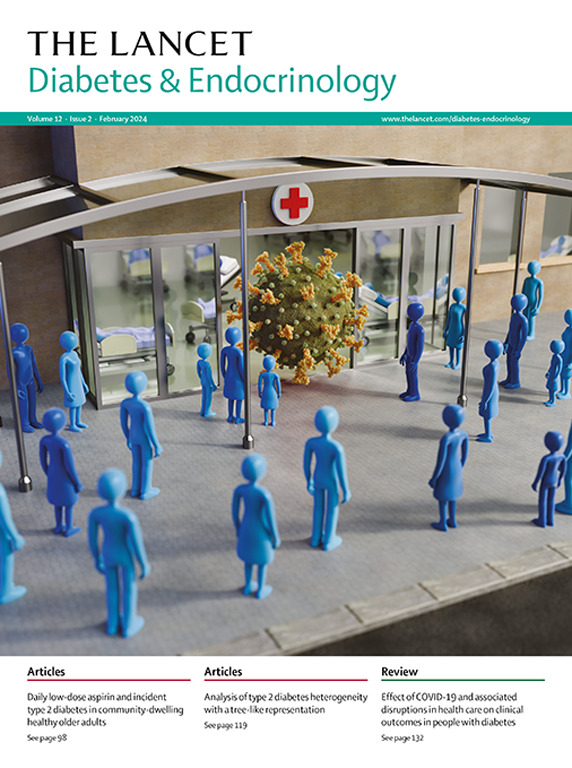Effect of gastric bypass versus sleeve gastrectomy on the remission of type 2 diabetes, weight loss, and cardiovascular risk factors at 5 years (Oseberg): secondary outcomes of a single-centre, triple-blind, randomised controlled trial
IF 44
1区 医学
Q1 ENDOCRINOLOGY & METABOLISM
引用次数: 0
Abstract
Background
For individuals with obesity and type 2 diabetes, weight loss improves insulin sensitivity and β-cell function and can induce remission of diabetes. However, the long-term comparative effectiveness of standard gastric bypass and sleeve gastrectomy on remission of type 2 diabetes remains unclear. We aimed to compare the effects of gastric bypass and sleeve gastrectomy on type 2 diabetes remission, weight loss, and cardiovascular risk factors 5 years after surgery.Methods
We present a secondary analysis of a two-armed, single-centre, triple-blind, randomised controlled trial conducted at a public tertiary obesity centre in Norway. Adults (ie, age ≥18 years) with type 2 diabetes and obesity were randomly assigned (1:1) by a computerised random number generator to laparoscopic gastric bypass or sleeve gastrectomy, with balanced block sizes of ten. Study personnel, participants, and the primary-outcome assessor were all masked to the allocation until 1 year after surgery, after which further follow-up was open label. Changes in key secondary outcomes, including type 2 diabetes remission, weight loss, and cardiovascular risk factors, were assessed 5 years after surgery. The trial procedure estimand assessed treatment effects in all randomised participants, with data collected after conversional surgery removed from analyses. The trial was registered with ClinicalTrials.gov (NCT01778738) and was completed in December, 2022.Findings
Between Oct 15, 2012, and Sept 1, 2017, 319 patients were assessed for eligibility, resulting in 109 participants who were randomly assigned to gastric bypass (n=54) or sleeve gastrectomy (n=55). The baseline mean age was 47·7 years (SD 9·6), mean BMI 42·3 kg/m2 (SD 5·3), 72 (66%) were women, and 37 (34%) were men. 93 (85%) participants completed 5-year follow-up (47 [85%] in the sleeve gastrectomy group and 46 [85%] in the gastric bypass group). The proportions with remission of type 2 diabetes were higher after gastric bypass than after sleeve gastrectomy (HbA1c ≤6·0% 23 [50%] of 46 vs nine [20%] of 44, risk difference 29·5% [95% CI 10·8 to 48·3]; HbA1c <6·5% 29 [63%] vs 13 [30%], risk difference 33·5% [14·1 to 52·9]). Gastric bypass provided greater loss in bodyweight (mean 22·2% [95% CI 20·3 to 24·1] vs 17·2% [15·3 to 19·1], treatment difference 5·0% [2·4 to 7·7]) and lower LDL-cholesterol (treatment difference –0·5 mmol/L [–0·8 to –0·1]). The prevalence of erosive oesophagitis and Barrett's oesophagus was similar between groups, whereas pathological acid reflux occurred more frequently after sleeve gastrectomy (risk difference 51·1% [28·0 to 74·2]). More participants had symptomatic postprandial hypoglycaemia after gastric bypass than after sleeve gastrectomy (15 [28%] vs one [2%]).Interpretation
Gastric bypass was superior to sleeve gastrectomy regarding long-term remission of type 2 diabetes, weight loss, and LDL cholesterol concentrations, at the expense of a higher frequency of symptomatic postprandial hypoglycaemia. These findings could inform clinical practice and future guidelines regarding the preferred surgical procedure in patients with type 2 diabetes.Funding
Vestfold Hospital Trust.Translation
For the Norwegian translation of the abstract see Supplementary Materials section.胃旁路术与袖带胃切除术对 2 型糖尿病缓解、体重减轻和心血管风险因素在 5 年后的影响(Oseberg):单中心三盲随机对照试验的次要结果
本文章由计算机程序翻译,如有差异,请以英文原文为准。
求助全文
约1分钟内获得全文
求助全文
来源期刊

The Lancet Diabetes & Endocrinology
ENDOCRINOLOGY & METABOLISM-
CiteScore
61.50
自引率
1.60%
发文量
371
期刊介绍:
The Lancet Diabetes & Endocrinology, an independent journal with a global perspective and strong clinical focus, features original clinical research, expert reviews, news, and opinion pieces in each monthly issue. Covering topics like diabetes, obesity, nutrition, and more, the journal provides insights into clinical advances and practice-changing research worldwide. It welcomes original research advocating change or shedding light on clinical practice, as well as informative reviews on related topics, especially those with global health importance and relevance to low-income and middle-income countries. The journal publishes various content types, including Articles, Reviews, Comments, Correspondence, Health Policy, and Personal Views, along with Series and Commissions aiming to drive positive change in clinical practice and health policy in diabetes and endocrinology.
 求助内容:
求助内容: 应助结果提醒方式:
应助结果提醒方式:


